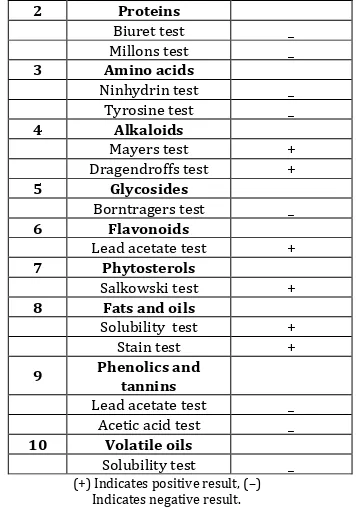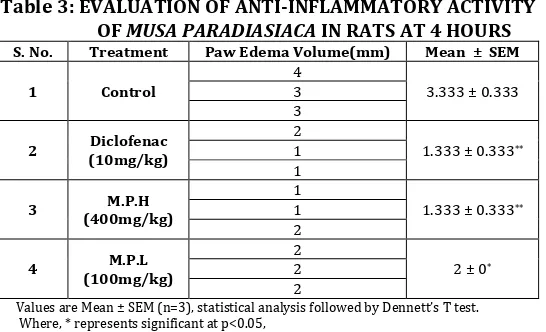INTERNATIONAL JOURNAL OF PHARMACEUTICAL, CHEMICAL AND BIOLOGICAL SCIENCES
Available online at
www.ijpcbs.com
EVALUATION OF ANTI INFLAMMATORY ACTIVITY OF MUSA PARADISIACA
(Linn.) LEAVES EXTRACT IN RATS
M. Hima Bindu
1*, Venkateswarlu Guddeti
2, T. Kala Praveen
3,
P. Sri Lakshmi Surekha
1, M.Gayathri
4, VS. Prakash Allam
4and Ch.Radha
41
Department of Pharmacetics, D.C.R.M. Phramacy College, Inkollu,
Prakasam Dist, Andhra Pradesh, India.
2
Department of Pharmacology, D.C.R.M. Phramacy College, Inkollu,
Prakasam Dist, Andhra Pradesh, India.
3
Department of Pharmaceutical Chemistry, D.C.R.M. Phramacy College, Inkollu,
Prakasam Dist, Andhra Pradesh, India.
4
D.C.R.M. Phramacy College, Inkollu, Prakasam Dist, Andhra Pradesh, India.
INTRODUCTION
Inflammation (Latin īnflammō, "I ignite, set alight") A localized reaction that produces redness, warmth, swelling, and pain as a result of infection, irritation, or injury. Inflammation can be external or internal.1 Edema formation, leukocyte
infiltration and Granuloma formation represent such components of inflammation.2 There are now
more than 50 different Non-steroidal Anti-inflammatory Drugs (NSAIDs) on the global market, some of the important examples are
Research Article
ABSTRACT
Inflammation is a localized reaction that produces redness, warmth, swelling, and pain as a result of infection, irritation, or injury. Inflammation can be external or internal. In traditional
system of medicine Musa Paradisiaca(Linn.) leaves The fruits are sweet, astringent,
emollient, Cooling, anthelmintic, aphrodisiac, antiscorbutic, demulcent and tonic. The leaves
are good for scabies and inflammations.Hence, the present study was aimed to explore the
possible anti -inflammatory activity of leaves extract of Musa Paradisiaca(Linn.) in
experimental animal models. For assessing of anti -inflammatory activity carrageenan induced paw edema model was used. Diclofenac was used as a standard reference for this
model. Shade dried leaves of Musa Paradisiaca(Linn.) were powdered and subjected to
Soxhlet extraction using alcohol and water. Hydroalcoholic extract was administered to the animals as suspension using 2% gum acacia for experimental purpose. Preliminary
photochemical investigation of the hydroalcoholic extract of Musa Paradisiaca(Linn.) leaves
reveals the presence of carbohydrates, flavonoids, Alkaloids, phytosterols, fats and oils.
Hydroalcoholic extract of Musa Paradisiaca(Linn.) leaves either up to the dose level of 2000
mg/kg did not produce any sort of mortality. However, the physical activity of the animals was reduced. In the treatment of carrageenan induced paw edema in rats, there was highly
significant decreased paw volume when treated with Diclofenac and high dose of Musa
Paradisiaca leaves extract. This activity may be due to presence of flavonoids, phytosterols and tannins in extract.
Aspirin, Celecoxib, Diclofenac, Ibuprofen, Indomethacin, aceclofenac etc.3
The classic signs and symptoms of acute inflammation1
Currently used Anti- inflammatory drugs are associated with some severe side effects like Gastric irritation, Anorexia, Diarrhea, Leucotrins, Rashes, Stomach ulcers, GIT bleeding, Kidney damage, Liver damage, Hypertension etc.4 Hence,
there is an increasing demand for the alternative therapies, particularly herbal therapies that are believed to be effective, safe and economical.
Musa Paradisiaca (Linn.) The fruits are sweet, astringent, emollient, Cooling, anthelmintic, aphrodisiac, antiscorbutic, demulcent and tonic. However, there is no authentic scientific data reported regarding anti-inflammatory activity of
Musa Paradisiaca (Linn.). In this context, in the present study an attempt is proposed to evaluate
the anti-inflammatory activity of Musa
Paradisiaca (Linn.) Linn leaves extract in rats.
OBJECTIVES
The main objective of the work is to evaluate the effect of Musa Paradisiaca (Linn.) leaves extract on anti-inflammatory activity in rats. The whole study is divided as follows:
Phase-I
Identification and authentication of the plant Musa Paradisiaca (Linn.)
Collection and shade drying of Musa Paradisiaca (Linn.) leaves.
Powdering of shade dried leaves for extraction
Preparation of hydro alcoholic extract of leaves of Musa Paradisiaca (Linn.) using Soxhlet apparatus.
To carry out preliminary phytochemical investigation of the extract.
To carry out toxicity studies and
determine the LD50-dose selection for the
considered as low and high doses respectively.
Phase-II
To study the effect of hydro alcoholic extract of Musa Paradisiaca (Linn.)
leaves in rats.
Carrageenan induced paw edema method
MATERIALS AND METHODS
Preparation of hydro alcoholic extract5
The powder of Musa Paradisiaca (Linn.) leaves was charged in to the thimble of a Soxhlet apparatus and extracted using 70% ethanol and 30% water for 18 hrs. Appearance of colorless solvent in the siphon tube was the indication of exhaustive extraction and based on that, further extraction was terminated. The extract was then transferred into the previously weighed empty beaker and evaporated to a thick paste on the water bath, maintained at 50oC to get alcoholic
extract. The extract was finally air dried thoroughly to remove all traces of the solvent and the percentage yield was calculated. The perfectly dried extract was then stored in an air tight container till used.
Acute oral toxicity study by using OECD 425 guidelines
This test procedure is used here because to minimize the number of animals required estimating the acute oral toxicity of chemicals, drugs and also in estimating a median lethal dose. The median lethal dose allows for comparison with historical data. In addition to the observation of mortality, it allows the observation of signs of toxicity.
The latter is useful for classification purposes and in the planning of additional toxicity tests.6
Evaluation of Anti-inflammatory activity Carrageenan induced Hind paw edema in Albino Wistar rats
Experimental animals
Albino Wistar rats of either sex weighing 150– 200 g were maintained in animal house and they were divided in to 4 groups of 6 animals each. Prior to the experimentation they were acclimatized to housing conditions for at least one week period of time to adjust to the new environment providing with food and water and
English Latin
Redness Rubor*
Swelling Tumor*
Heat Calor*
Pain Dolor*
p.m. Institutional animal Ethical Committee approval was obtained before carrying out this experiment.
Grouping and treatment
Group I--- Control, animals were treated with 10% Tween-80 p.o
Group II--- Standard group, animals were treated with 10mg/kg Diclofenac sodium.
Group III---Animals were treated with 30mg/kg b wt. p.o of hydro alcoholic extract of Musa
Paradisiaca (Linn.) leaves.
Group IV--- Animals were treated with 60mg/kg b wt. p.o of hydro alcoholic extract of Musa
paradisiaca (Linn.)leaves.
Procedure
After 60 minutes of the respective treatments, Carrageenan (0.1ml of 1% w/v) was injected into sub plantar region of right hind paw. Paw volume was measured every hourly interval for a maximum of six hours by using mercury plethysmograph. Reduction in the paw volume was compared with the vehicle control.7
RESULTS
Table 1 : Phytochemical constituents present in Musa paradisiaca (Linn.) leaves extract
S.
No. Test
Hydro alcoholic
extract 1 Carbohydrates
Benedicts test +
Fehling’s test +
2 Proteins
Biuret test _
Millons test _
3 Amino acids
Ninhydrin test _
Tyrosine test _
4 Alkaloids
Mayers test +
Dragendroffs test +
5 Glycosides
Borntragers test _
6 Flavonoids
Lead acetate test +
7 Phytosterols
Salkowski test +
8 Fats and oils
Solubility test +
Stain test +
9 Phenolics and tannins
Lead acetate test _
Acetic acid test _
10 Volatile oils
Solubility test _
(+) Indicates positive result, (–) Indicates negative result.
Acute Oral Toxicity Study
For the LD50 dose determination, hydro alcoholic
extract of Musa paradisiaca (Linn.) leaves was administered up to dose 2000 mg/kg body weight and extract did not produce any mortality, thus 1/5th, 1/10th, 1/20th of maximum dose tested
were selected for the present study .
LD50 of Hydro alcoholic extract of Musa
paradisiaca (Linn.) leaves was found to be –2000
mg/kg.
Table 2: EFFECT OF HYDRO ALCOHOLIC EXTRACT OF MUSA PARADISIACA ON CARRAGENAN INDUCED PAW OEDEMA IN RATS AT 0 min, 30min, 1hr, 2 hrs and 4 hrs
Group Animal 0 min 30 min 1 hr 2 hrs 4 hrs
Control
Head 4 mm 4 mm 4 mm 4 mm 4mm
Body 3 mm 3mm 4 mm 4 mm 3 mm
Tail 3 mm 4 mm 4 mm 4 mm 3 mm
Standard
Head 4 mm 4 mm 3 mm 2 mm 2 mm
Body 4 mm 3 mm 3 mm 2 mm 1 mm
Tail 3 mm 4 mm 3 mm 2 mm 1 mm
High dose 400mg/kg
Head 3 mm 4 mm 4 mm 3 mm 1 mm
Body 4 mm 4 mm 4 mm 2 mm 1 mm
Tail 3 mm 4 mm 3 mm 2 mm 2 mm
Low dose 100mg/kg
Head 4 mm 3 mm 3 mm 2 mm 2 mm
Body 3 mm 3 mm 4 mm 3 mm 2 mm
Table 3: EVALUATION OF ANTI-INFLAMMATORY ACTIVITY OF MUSA PARADIASIACA IN RATS AT 4 HOURS S. No. Treatment Paw Edema Volume(mm) Mean ± SEM
1 Control 4 3 3.333 ± 0.333
3
2 (10mg/kg) Diclofenac
2
1.333 ± 0.333**
1 1
3 (400mg/kg) M.P.H 1 1 1.333 ± 0.333**
2
4 (100mg/kg) M.P.L
2
2 ± 0*
2 2
Values are Mean ± SEM (n=3), statistical analysis followed by Dennett’s T test. Where, * represents significant at p<0.05,
** represents very significant at p< 0.01 when compared to Control group.
R.S.H (400 mg/kg) and R.S.L (100 mg/kg) are the high and low doses of Musa paradisiaca Linn.
DENNETT'S T test
Control
Standard High dose Low dose
0
1
2
3
4
Treatment
Vo
lu
m
e
of
P
aw
e
d
em
a
DISCUSSION
There are a number of synthetic non steroidal anti inflammatory drugs (NSAIDs) currently available for use in the management, control and treatment
therefore, there is a great need for the development of cheap, effective and safe NSAIDs from plants and other sources.
studied in carrageenan induced paw edema in rats.
The inhibition of Carrageenan- induced
inflammation in rats is an established model to
screen compounds for potential
anti-inflammatory activity. It is well known that Carrageenan induced paw edema is characterized by biphasic event with involvement of different inflammatory mediators. In the first phase (during the first 2 h after Carrageenan injection), chemical mediators such as histamine and serotonin play role, while in second phase (3 – 4 h after Carrageenan injection). Kinin and prostaglandins
are involved. Our results revealed that
administration of Hydro alcoholic extract of root
Musa paradisiaca Linn. Inhibited the paw volume
after third hour and during all phases of inflammation, which is probably inhibition of different aspects and chemical mediators of inflammation.
Animals treated with standard drug like Diclofenac (10mg/kg) produces highly significant paw edema volume when compared to control animals. Whereas, high dose of 400 mg/kg Musa paradisiaca hydro alcoholic extract produces highly significant decreased paw edema volume which is similar to the response of Diclofenac treatment. When compared to control animals. In case of low dose 200 mg/kg Musa paradisiaca hydro alcoholic extract produces significant decreased paw edema volume when compare to control animals.
The hydro alcoholic extract of Musa paradisiaca showed potent anti-inflammatory activity may be due to the presence of flavonoids, phytosterols and tannins and also due to inhibition main inflammatory mediators like Histamine, serotonin,
Prostaglandins, Bradykinin, Angiotensin,
Trachykinin, platelet activating factor and substance-p
Hence it is concluded at the Musa paradisiaca possesses significant anti-inflammatory activity against carrageenan induced paw edema in rats.
CONCLUSION
The present study was carried out to find out the evaluation of anti-inflammatory activity of Musa paradisiaca leavess in rats.
From the results we concluded that the Musa paradisiaca leaves extract at high and low doses produces highly significant and significant decreased in carrageenan induced paw edema in rats. This activity may be due to presence of flavonoids, phytosterols and tannins in extract. However, long term studies in different animals and inflammation subjects may further substantial our study result.
REFERENCES
1. http://en.wikipedia.org/wiki/Inflammati on accessed on Mar 20,2012
2. Mitchell RN and Cotran RS. Robinsons Basic Pathology. 7th ed, Harcourt Pvt. Ltd.
New Delhi, India. 2000:33-42.
3. Rang HP, Dale MM, Ritter JM and Flower RJ. Pharmacology. 6th ed. Edinburgh
(England) Harcourt Publishers Ltd. 2007:226-31.
4. Achinto S, Muniruddin A. The Analgesic and Anti-inflammatory activities of the extract of Albizia Lebbeck in animal model. Pak J Pharm Sci. 2009;1(22):74-77.
5. Kokate CK. Practical Pharmacognosy.
Vallabh Prakashan, New Delhi,
1994;4:110-111.
6. OECD guidelines for testing of chemicals 425, 17th December 2001.

